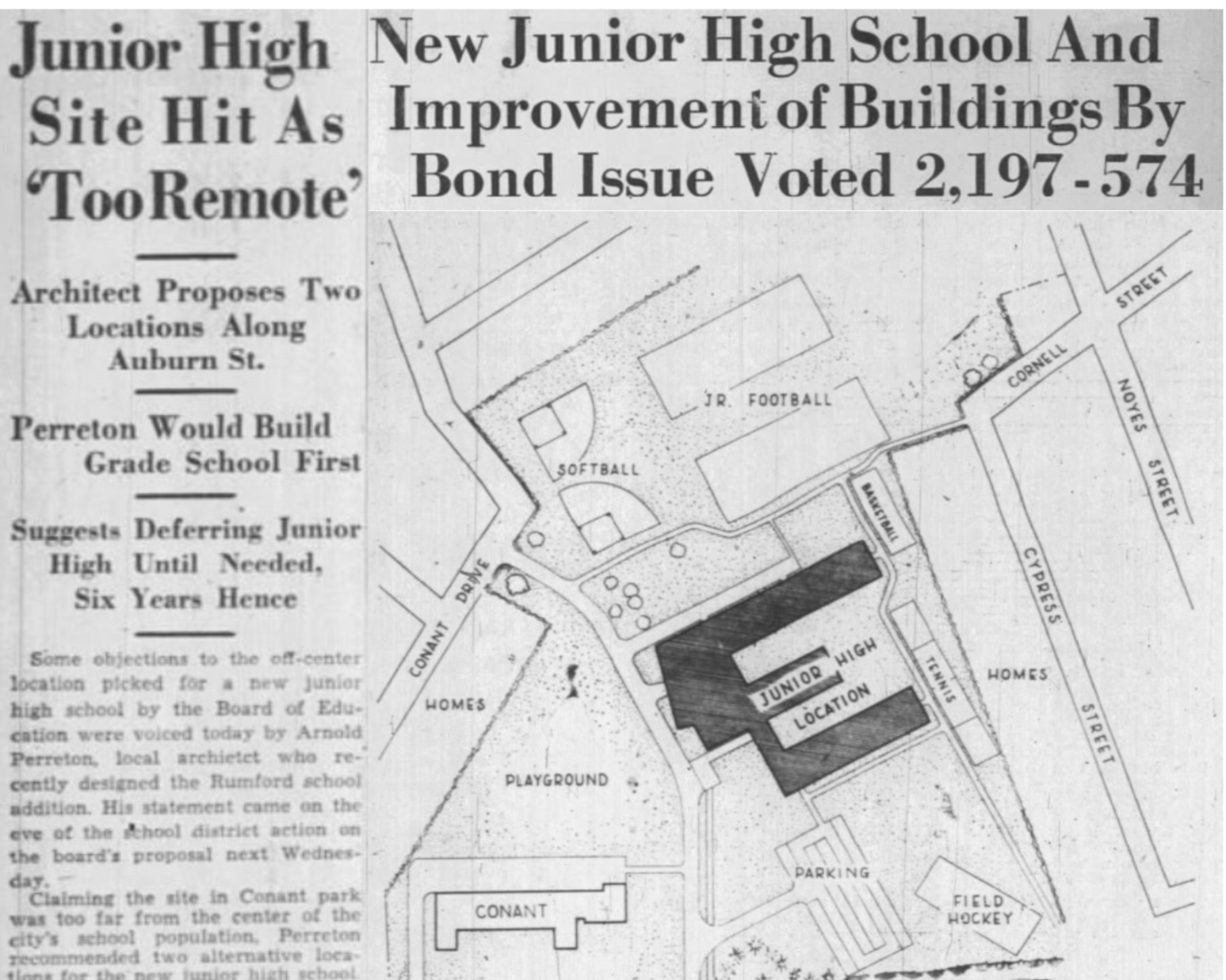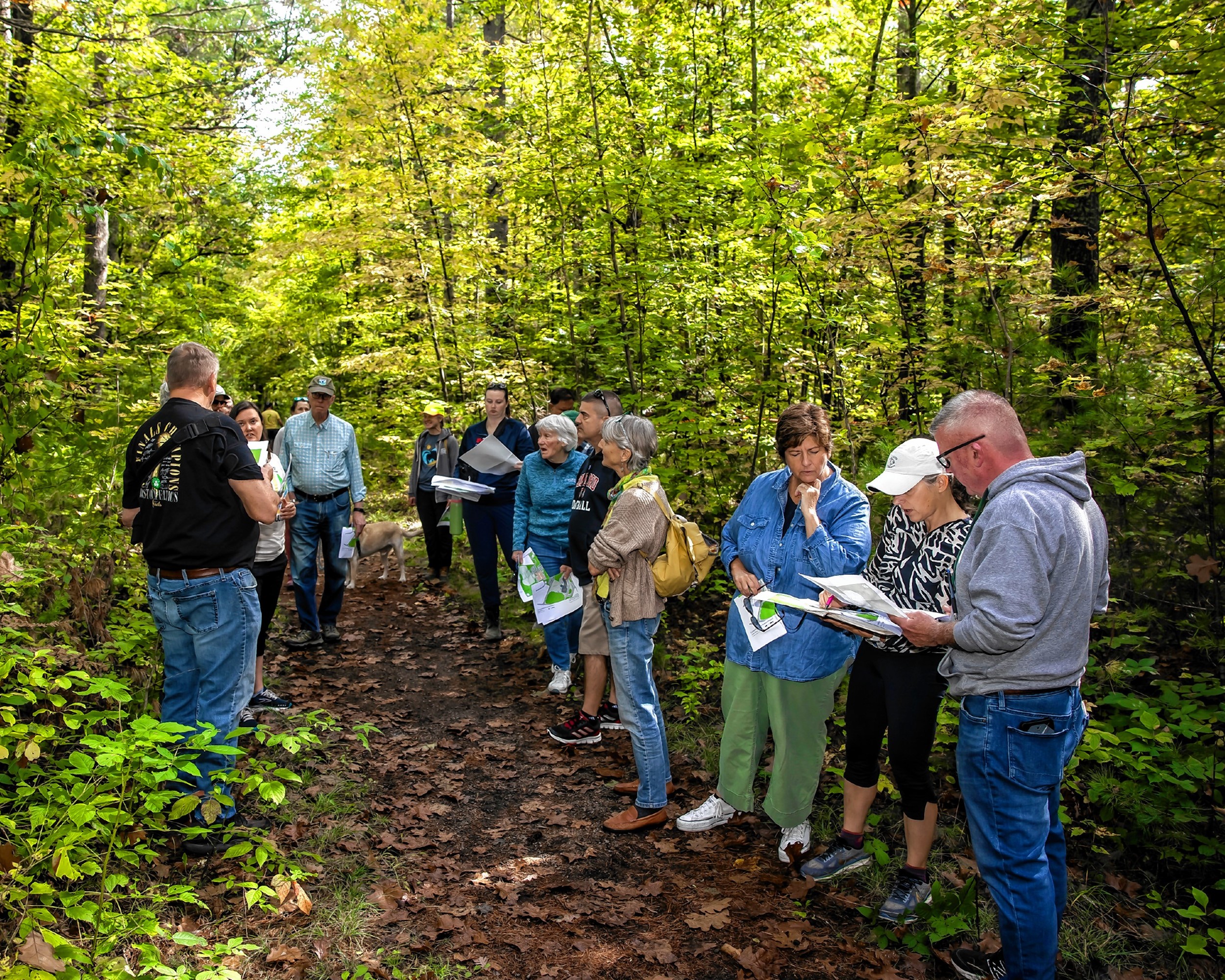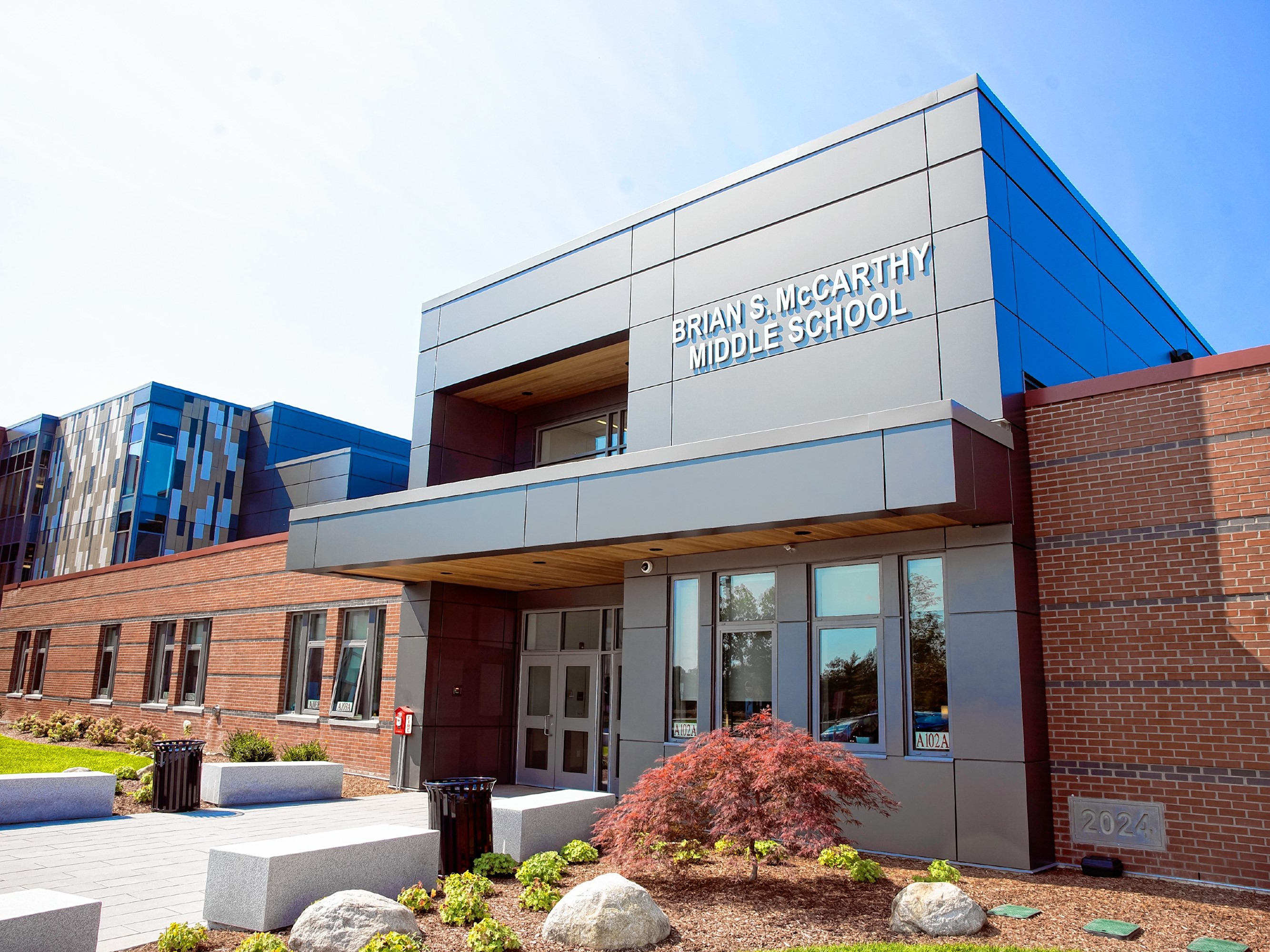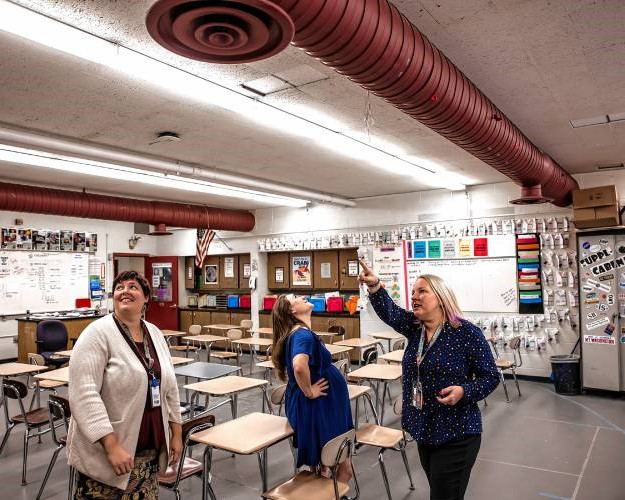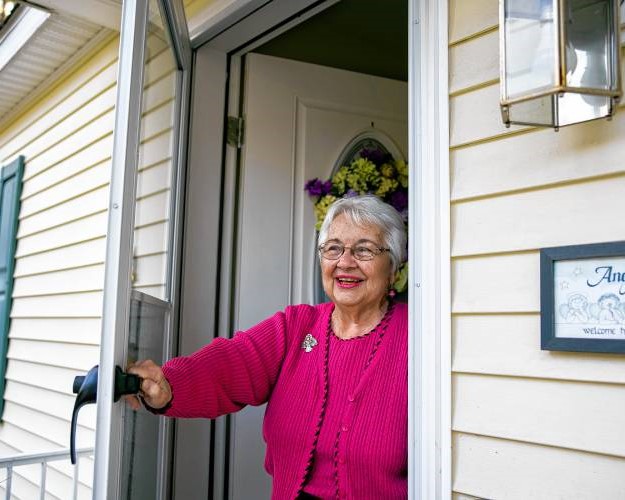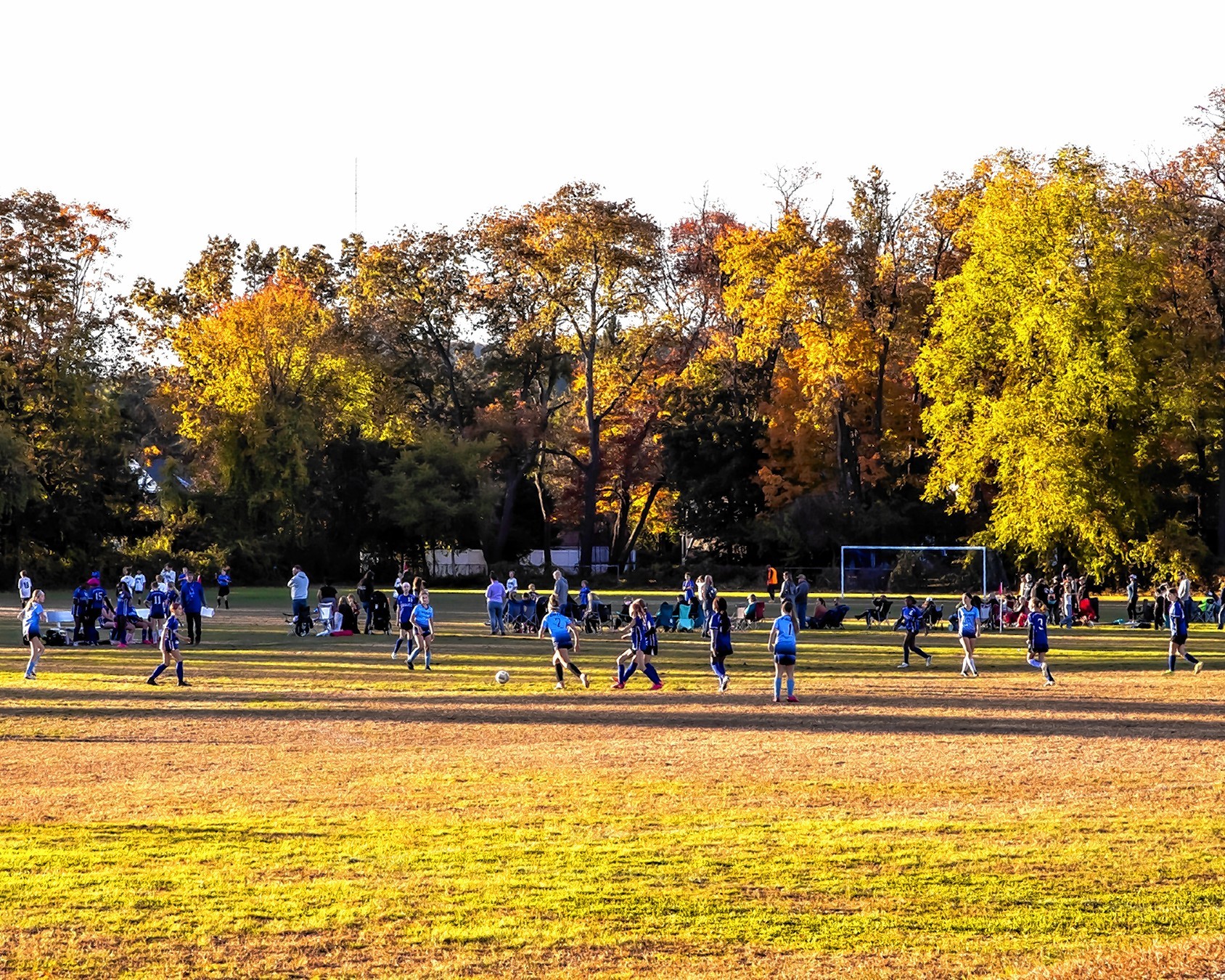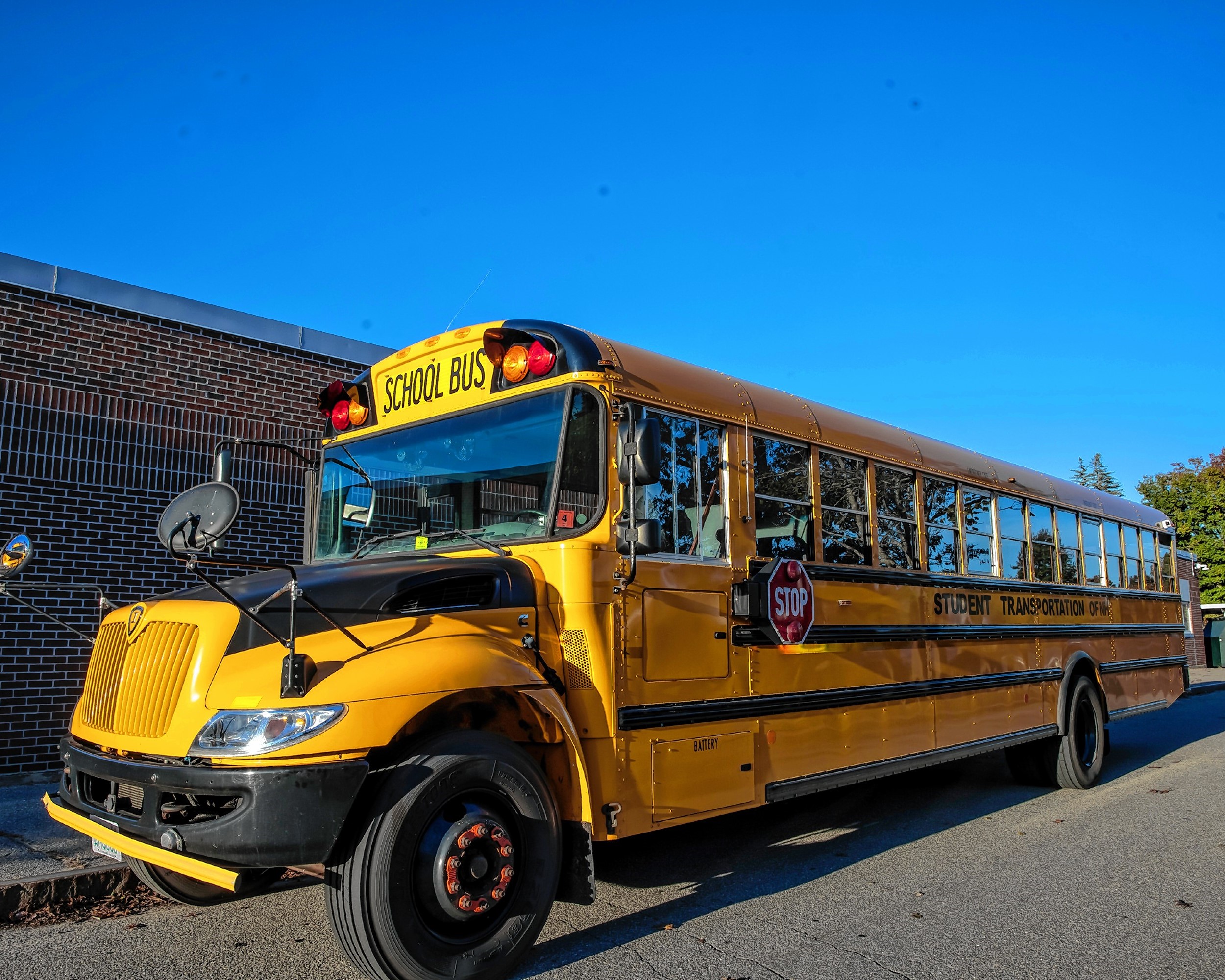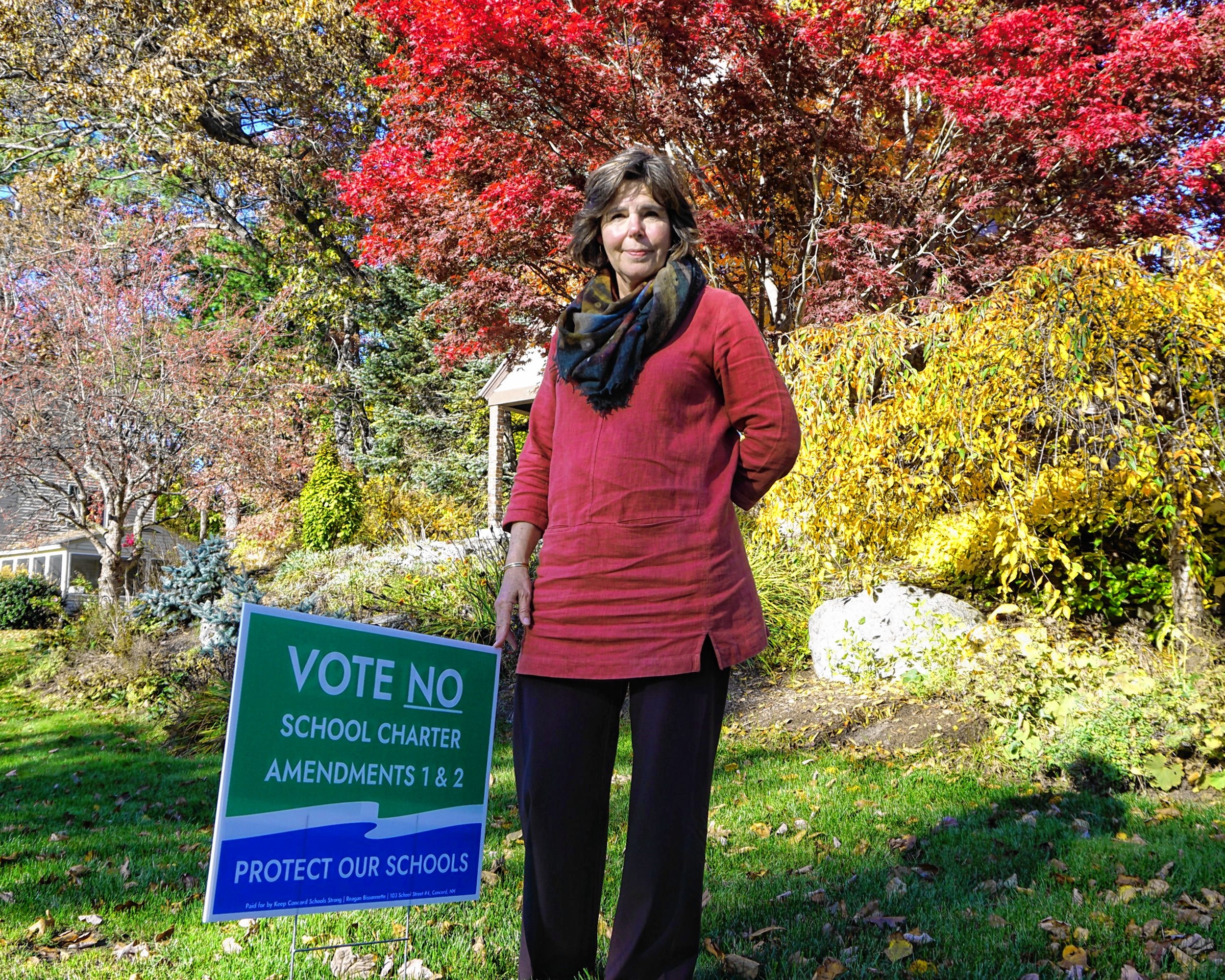
RETHINKING RUNDLETT

The future of Concord’s middle school hangs in the balance as two referendums challenge the decision to build at Broken Ground. Over the next several days, the Monitor looks at key issues ahead of a Nov. 5 vote.
On This Page:
The origin story for what is now Rundlett Middle School echoes the current debate to replace it, with one fundamental difference.
Unlike its 1955 counterpart, members of the school board last year didn’t have to convince voters to back their choice when they chose a location for the new school.
It may prove to be the project’s fatal flaw.
Read the story here.
In email exchanges, meetings and interviews, board members have been earnest about why they believe Broken Ground is truly the better location. They've also shared ample documents on a website dedicated to the Middle School Project.
Yet when it comes to a central assertion behind moving the school to Broken Ground — that relocating would be cheaper than rebuilding at Rundlett — the district and its contractors have refused to show their work.
Read the story here.
Concord’s proposed middle school is estimated at $152 million, making it the most expensive school project in the last 20 years to seek building aid. In contrast, Nashua built a similarly sized middle school for $92 million.
The Concord School District attributes the price gap to inflation, noting that Nashua locked in its costs pre-COVID. Still, Concord's price is at least $25 million expensive, accounting for inflation. Here's a look at the new Nashua school.
Read the story here.
While yard signs make it seem that all of Concord is talking about Rundlett, one key voice is missing: marginalized communities.
Despite equity being a reason cited for relocating the school, community leaders say that immigrant families that live near Broken Ground have been left in the dark - with little out reach in other languages or efforts to engage their opinion on the new school location.
Read the story here.
Amid the debate over the middle school, the views of Rundlett’s educators have been largely absent.
In one classroom, a bird laid eggs in the pipes. In another, plants sprouted in the sink.
As the current building deteriorates, one sentiment is clear among teachers: a new school is needed as soon as possible.
Read the story here.
Do opponents of the Broken Ground site represent the city at-large or are they a vocal minority? We conducted a citywide poll to find out.
Monitor reporters knocked on doors of 100 Concord residents. While more people believe the school board made the wrong decision than the right one last year, the city is evenly split on whether that decision should be reversed now.
Read the story here.
The future of middle school athletics in Concord is in limbo between possible construction at Broken Ground, a renovation of Memorial Field, and the current space at Rundlett.
All sides have different wants and needs, and finding the sweet spot is the tricky part.
Read the story here.
Moving the school to Broken Ground could add 100 to 150 pupils to the roster of more than 2,000 students eligible for bus rides.
That increase is partly because the district doesn’t ask students to cross the overpass bridge above I-393 at Exit 2 even if they live close enough to walk to school at the new site, which increases the number of homes eligible to ride the bus.
How does this impact busing costs?
Read the story here
Rundlett has far fewer students than the 900 projected for a new school.
The city itself is projected to grow about 5% by 2030 but the state’s population of 10-14-year-olds may actually decline over that time before rebounding.
But many variables could affect that, from zoning changes to climate change migration.
Read the story here
Kass Ardinger chaired the school board just over a decade ago. At the time elementary school consolidation was divisive, just like Rundlett is now.
At the time, a group of opponents tried unsuccessfully to get the Legislature to step in and override the board.
Today, Ardinger, and others, warn against the two charter amendments on Concord's ballots.
Read the story here.
Candidate Converations
The Concord Monitor hosted a two-part event on Thursday, Oct. 24, at the Christa McAuliffe Auditorium at Concord High School.
The evening featured a forum with the six candidates vying for three seats on the Concord School Board: incumbents Pamela Walsh (the current president) and Barb Higgins; and challengers Andrew Winters, Sarah Sadowski, Joseph Scroggins, and Clint Cogswell.
The Monitor staff also talked through the "Rethinking Rundlett" series, moderated by participants from the Reader Advisory Board. Watch both videos below:
Poll results
The Monitor knocked on 100 doors in Concord to learn about resident's views on the middle school decision. Here's a breakdown of what we found:
Cost Comparisons
Concord’s new middle school is projected to cost $152 million. The district says it’s because of inflation. But, even accounting for inflation other school districts' past construction will still be $100 million less than what Concord plans to spend in 2026.
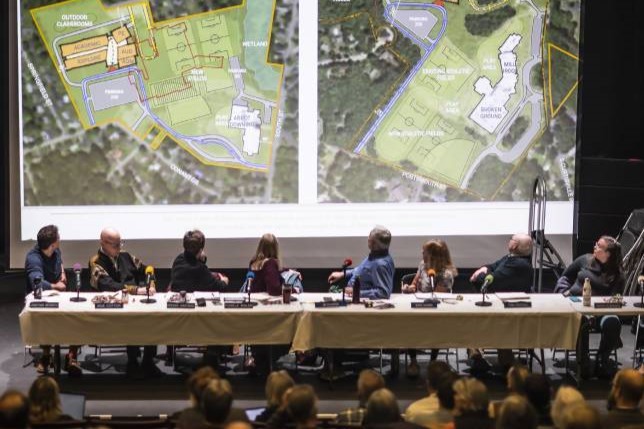
In December, Concord School Board members voted 6-3 to relocate the middle school despite overwhelming testimony at the public meeting in favor of rebuilding at the current Rundlett site. Above, school board members look at two site plans.
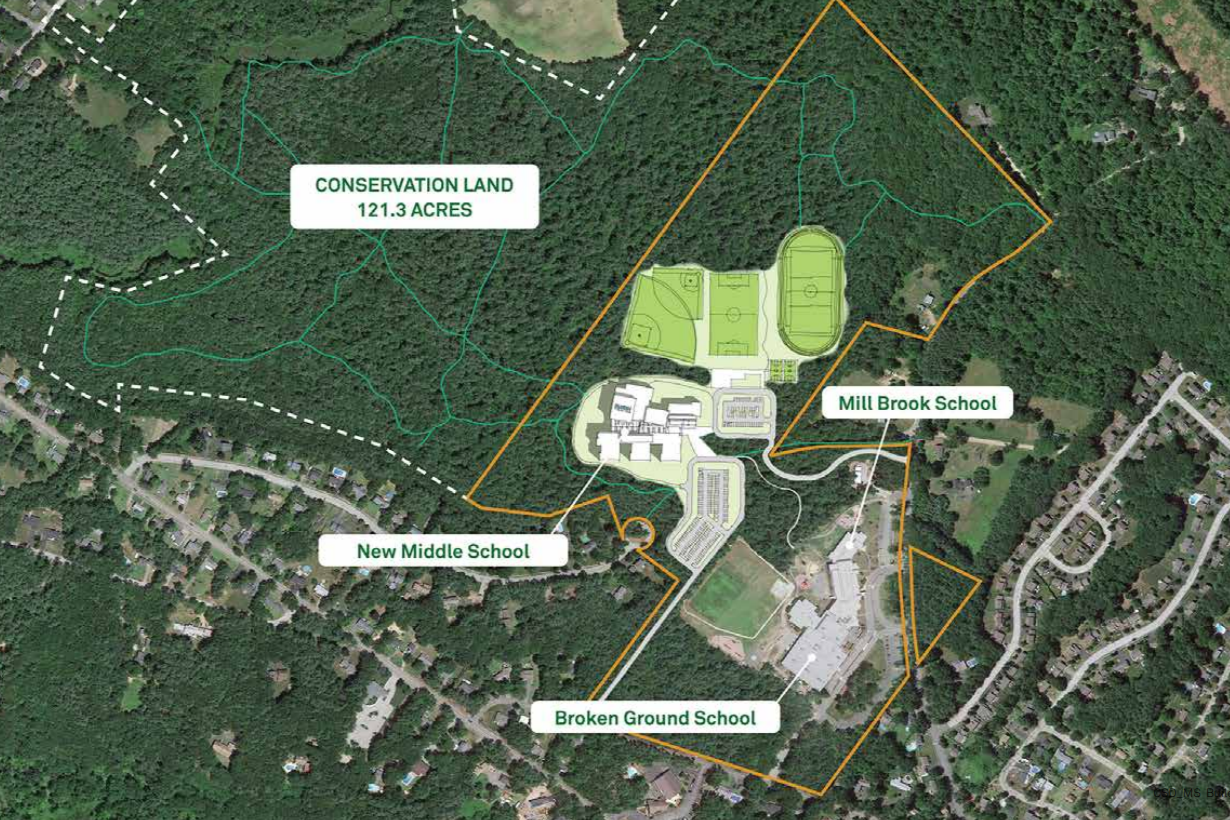
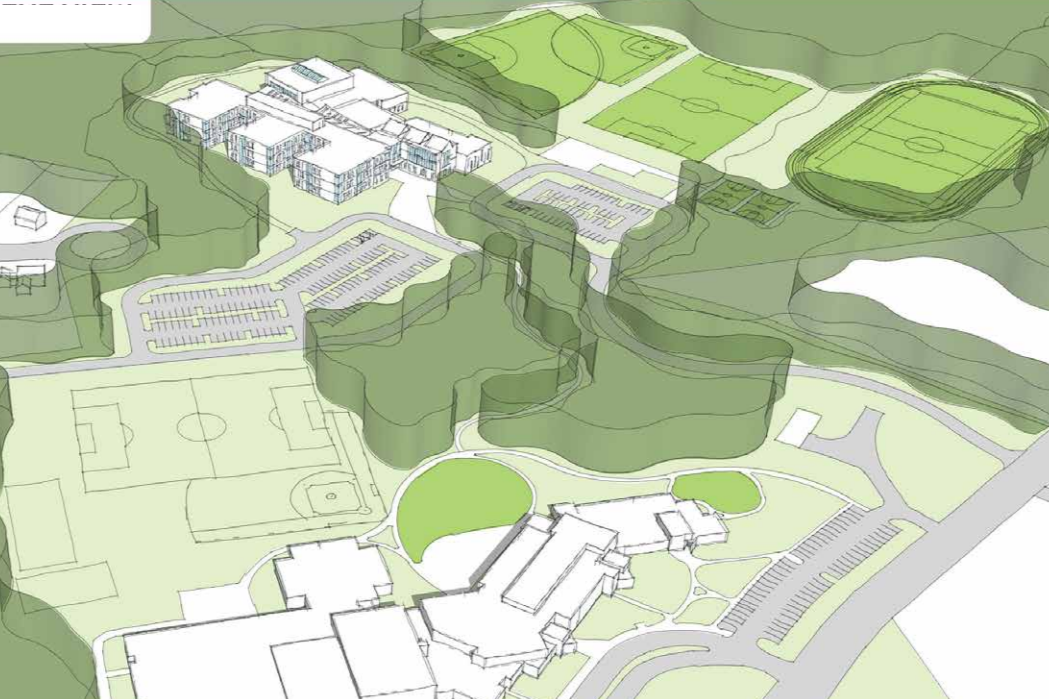
Plans for the new site include conservation land and athletic fields in addition to the new school next to the Broken Ground and Mill Brook Elementary Schools.
What You Need to Know for Nov. 5
When voters head to the polls in Concord on November 5th, the middle school decision will be on the ballot. A pair of amendments, added to the ballot through a citizen's petition, look to challenge the Concord School Board's autonomy and require they receive voter approval before deciding to relocate a school or purchase property. Six candidates are also running for three seats on the board.
Here's the Monitor's prior coverage of the upcoming election:
Should the Concord school board retain its autonomy? It will take a supermajority to change it
Concord School Board’s president and longest serving member both seeking another term
Six candidates, three seats: school board race slated to be referendum on Middle School project
Vote to move middle school motivates another candidate to run for Concord School Board
Generational divide begins to emerge over Concord School Board charter amendments
Concord residents voice rare opposition to reopening debate on location of new middle school
With three at-large seats on the line, filing period for Concord School Board opens
State OKs school district charter amendments as community tensions flare
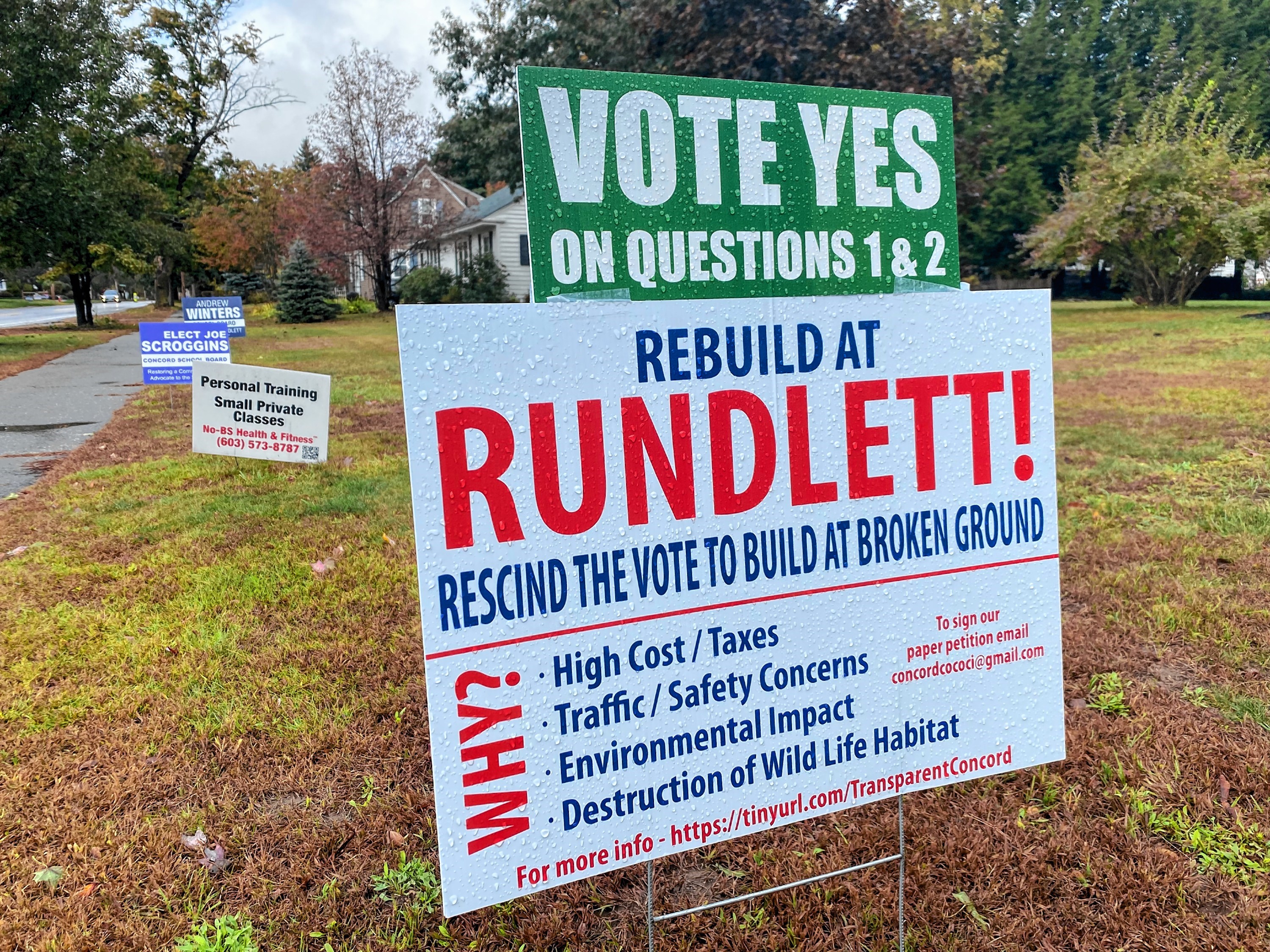
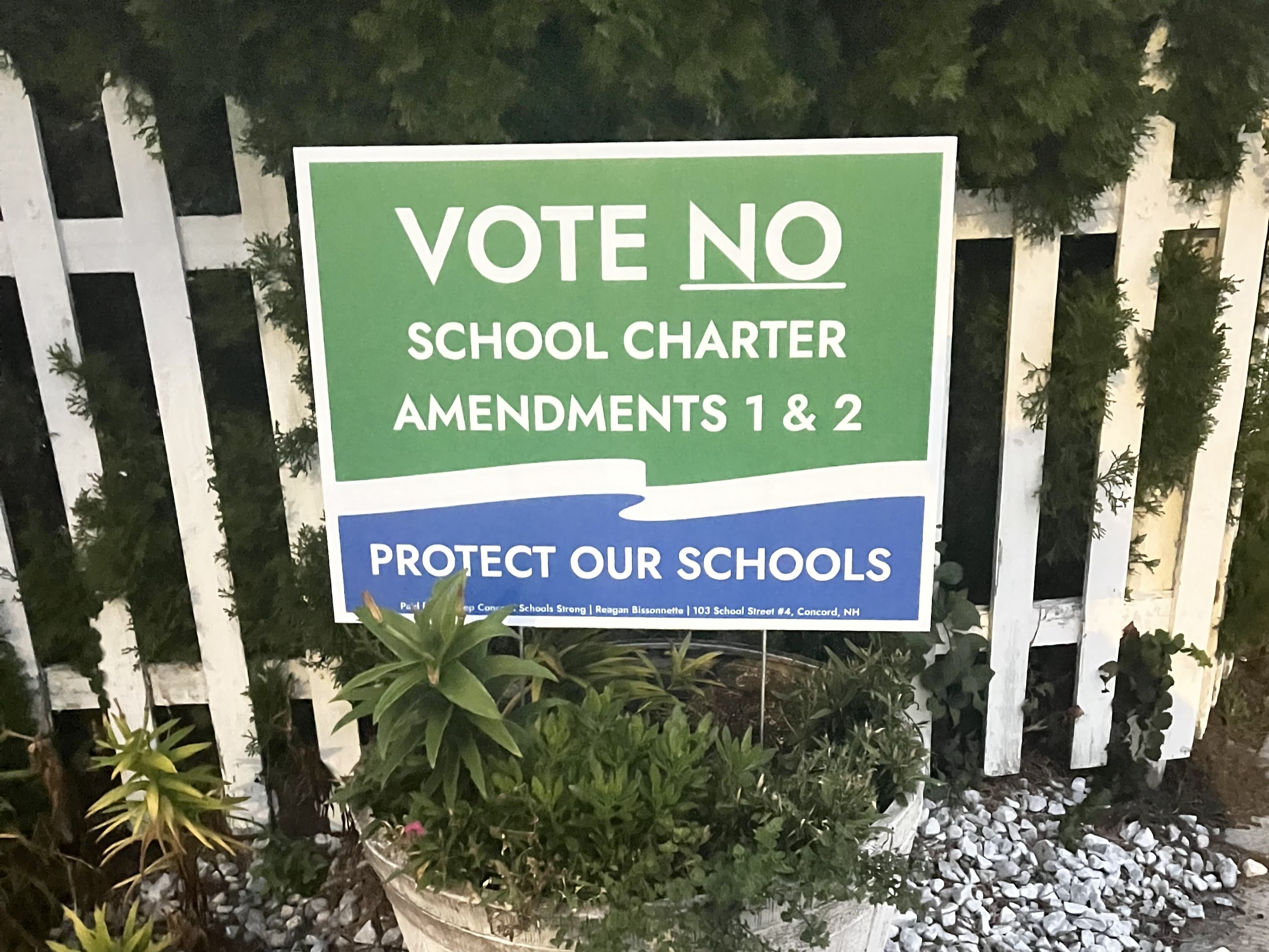
Across Concord lawns, yard signs indicate support for rebuilding at the current Rundlett site, and support for the two charter amendment (left), while counter signs encourage voters to reject the amendments (right).

From top left to bottom right: Clint Cogswell, Sarah Sadowski, Joe Scroggins, Andrew Winters, Barb Higgins and Pamela Walsh.
On November 5, poll will be open from 7 a.m. to 7 p.m. in Concord.
Click here to find your polling location.
Reporters' Recaps
Hear from Monitor reporters themselves about each component of the series
Catherine McLaughlin breaks down her first two stories: the parallels between the city's original plans for Rundlett and remaining cost questions about the new plans.
Sruthi Gopalakrishnan walks through the cost comparison between Concord's project and recent school construction in Nashua. Even adjusted for inflation, Concord's exceeds by at least $25 million.
In a conversation about equity in the district, marginalized voices are left out of the conversation. With little engagement for non-native English speakers, community leaders told Michaela Towfighi they worry about the impact of relocating the middle school on families who are unaware of the decision.
The current Rundlett building is falling apart as teachers try to make do in their classrooms. Jeremy Margolis spoke with five middle school teachers about the need for a new building and their support for that project happening as soon as possible.
To gauge opinions on the middle school decision, the Montior conducted a poll of city residents. We knocked on 100 doors with a survey. Jeremy Margolis breaks down this process and what we found.
With plans to renovate Memorial Field and new athletic facilities included in Rundlett maps, Alexander Rapp looks at how the new school will impact field space for students.
While relocating the school to Broken Ground will increase the number of middle school students eligible for bus rides, busing costs aren't expected to go up with the new school. David Brooks breaks down transportation and population estimates.
Conversation about the future of Rundlett has spanned a near decade in Concord. Need a refresher? The Monitor made a timeline of major decisions this spring.
Frequently Asked Questions
Timeline, Cost Comparison and Plans
Q: When did the school board first start working on the middle school? When did they choose the new location at Broken Ground?
A: The board officially started studies for a new school in 2016. In 2019, they voted to rebuild rather than renovate the existing school. They chose the Broken Ground location in December, 2023 over keeping the school on South Street.
Q: How much will it cost?
A: The budget cap for the project is $152 million. In a best-case scenario, where the district applies its capital reserve savings and gets the highest amount of building aid available to them, that would be an increase of $207 in the first year on the tax bill of a $350,000 home.
Q: Is it true that the Rundlett site is more expensive to build on?
A: Without a full breakdown of current costs for the Broken Ground site, it’s difficult to show that one site is more or less expensive than the other. A cost estimate from 2023 showed that Rundlett had higher site work costs, but the Broken Ground development plan has drastically changed since that comparison was completed.
Q: How big is the new school? How big is Rundlett?
A: The new school is 203,000 square feet. Rundlett is 156,119 square feet. Part of what makes up the difference includes the addition of a 450-seat auditorium, larger music and art spaces, and larger classrooms — many in Rundlett are below the state minimum size.
Q: How many acres of trees and forest will be cut down for the new school at Broken Ground?
A: Originally, when the board chose the location last year, that number was 8 acres. Since, it has ballooned: the school moved further out into the property, and sports fields were moved behind the school. Now, the total is approximately 24 acres. For scale, that’s equivalent to roughly 20 football fields.
Q: What is the cost of the site work and infrastructure improvements at the new site?
A: This is unknown. While that work is included in the $152 million budget, Concord school district officials and HMFH Architects would not provide an estimate for site work that was updated for the current design and development footprint.
Q: Is this decision to build a school on the East Side of Concord irreversible?
A: No, but a reversal would delay the start of construction by about two years, according to the district. It also would introduce new costs, including increased design costs, a longer duration of construction work, and the demolition of the old building to make room for new athletic fields.
Q: If the school board chose to reverse course and rebuild at Rundlett, could the school building they
designed for Broken Ground go there?
A: No. The architects would use the same input and goals, but the floor plan would have to be redone to fit on the property beside the existing school.
Q: Do they have to build a new school? Couldn’t part of the existing school be renovated to reduce costs?
A: in 2017, the district was told that renovating the current building would cost approximately the same amount as building a new school. To get more features for roughly the same costs, they voted in 2019 to build anew.
Q: What will happen to Rundlett if the move to Broken Ground happens?
A: Nobody knows. Several district leaders have floated the idea of making it the new home of the Concord Regional Technical Center, which is outgrowing its space at Concord High. Nothing has been decided yet. If the district opts to sell the building, the City of Concord has the right of first refusal.
Nashua Comparison
Q: How does the size of the Nashua and Concord middle schools compare?
A: Concord’s middle school is estimated to be 203,000 square feet, while Nashua’s is slightly larger at 212,000 square feet.
Q: How does the cost of the two schools compare?
A: Nashua built its new middle school for $92 million and spent a total of $130 million to construct the middle school and renovate two others. Concord’s middle school project is estimated to cost $152 million.
Q: What are some other similarities between the two schools?
A: Nashua has built its middle school on undeveloped land. Concord has also chosen raw land to build its middle school. Both schools are designed to accommodate similar projected enrollments, with Nashua planned for 800 students and Concord projected at 900.
Q: Even adjusted for inflation, why is the Concord school so much more expensive?
A: Concord officials have pointed to rising construction costs, but that still doesn't bridge the difference. Every school is different and the answer is included partially in the building's design and features. Without a breakdown of the total project, an exact answer is impossible.
Q: How does the new Concord school compare to other NH school construction projects?
A. In the last 20 years, state building aid applications indicate that no other school project in New Hampshire has approached the cost and scale of Concord’s proposed middle school.
Equity and Diversity
Q: Are New American families being engaged in the planning process for a new Concord middle school?
A: Non-native English-speaking families have expressed feeling excluded from the decision-making process. Key information has largely been communicated in English only, making it difficult for families whose first language is not English to fully understand or participate in discussions around the new middle school.
Q: What role does diversity and equity play in the decision-making and planning for the new school?
A: While diversity and inclusion are among the district’s stated priorities, families and community leaders are concerned that these principles are not being fully integrated into the planning process. Many have noted the lack of outreach to culturally diverse communities, which they feel perpetuates a disconnect between district leaders and families of color.
Q: What are some potential benefits of relocating the middle school from the South End of Concord to the East Side?
A: Supporters of the relocation believe that placing the middle school in East Concord could lead to greater investment in the Heights area, such as improved infrastructure, new sidewalks, and better traffic patterns. They see this as a necessary step to make the city more accessible and equitable for all residents.
Q: What are some potential drawbacks of relocating the middle school?
A: Community leaders have raised concerns about relocating the middle school as they fear it will cut off transportation to Concord’s downtown for families. Memorial Field, the YMCA and the Boys and Girls Club are a few of many facilities middle school students access near Rundlett’s current location in the South end.
Q: What do the charter amendments say?
A: No Concord public school existing as of January 1, 2024, including but not limited to the District’s middle school, (Rundlett Middle School), shall be relocated from the parcel on which it was situated as of January 1, 2024, to be rebuilt or replaced elsewhere, without an affirmative simple majority vote of Concord School District voters voting on the question ratifying such relocation.”
And:
“No parcel of real property owned by the Concord School District, larger than one acre, shall be sold, gifted, or exchanged by the district without an affirmative simple majority vote of Concord School District voters voting on the question.”
Q: What is the distance between the current Rundlett site and the proposed new location near Broken Ground?
A: The two sites are just over 5 miles apart. Relocating the middle school to East Concord means the new school will sit on the other side of the city, across the Merrimack River.
Q: How many students in the Concord School District are English Language Learners?
A: Mill Brook and Broken Ground elementary schools have the highest percentage of English Language Learners, non-native speaking students, with 15 and 18 percent respectively in 2023. The remaining three elementary schools – and Rundlett Middle School and Concord High School – all have populations of less than 10 percent.
Q: What are the demographic breakdowns of schools in Concord?
A: Mill Brook and Broken Ground elementary schools are the city’s most diverse, with 68.5 percent and 72 percent of students identifying as white, respectively. At Mill Brook 18 percent of students are Black and less than 10 percent are Asian or Pacific Islander. At Broken Ground, 15 percent of the student body is Black, less than 10 percent are Asian or Pacific Islander and less than 10 percent Hispanic or Latino. At the three other elementary schools – Christa McAullife, Beaver Meadow and Abbott Downing – over 84 percent of students identify as white.
Q: How many refugees have resettled in New Hampshire?
A: Since 2011, 4,574 people have resettled in New Hampshire, with one-third of that population, just over 1,500, moving to the Concord area. Immigration numbers hovered just above or below 200 from 2011 to 2016 before declining rapidly, to as low as 14 in 2020, before spiking again at 81 in 2022. Last year, 25 people resettled in Concord.
Q: What support is available in school for non-native English speaking students?
A: All schools in Concord have programming for English Language Learners that caters to all levels of English proficiency. “Push-in” instruction is available for students, where ELL teachers are in the classroom assisting material or students participate in “pullout” instruction, where they meet in small groups outside of class.
Q: What support is available for non-native English speaking parents?
A: All online communication from the school district can be translated with the use of Parent Square, the platform Concord uses to share announcements and other information. For in person school events, like back to school night, parents can request translators through the Language Bank, a translation service based in Manchester. Home-school liaisons also make visits to students houses to learn more about the families and connect with parents in their own space.
City Poll and Charter Amendments
Q: Why did the Monitor decide to conduct a citywide poll?
A: Vocal criticism of the school board’s decision to build a new middle school on the Broken Ground site has dominated discussion on this issue. We wanted to glean how widely these views were represented in the city. We decided a random survey was the best way to do so.
Q: What do the poll results tell us?
A: Residents are about evenly split on whether the middle school decision should be reversed. The most uniform agreement came with respect to the charter amendments, which nearly three-quarters of respondents supported.
Q: What did we do?
A: Nine reporters fanned out across the city to randomly-selected streets in each of the city’s wards (except ward 1, which is primarily in the Merrimack Valley School District). Reporters ultimately polled 100 people on 36 different streets. More details about our methodology can be found at the bottom of the story itself.
Q: What’s the deal with these charter amendments?
A: A group of residents frustrated by the decision to relocate the middle school gathered enough signatures to put two questions on district voters’ ballots that would strip the school board of some of its autonomy. Notably, neither amendment would automatically reverse the decision to build the new middle school at the Broken Ground site, but one of them could prompt a separate district-wide vote on the location. More on that below.
Q: What do the amendments say?
A: The first question says: “No Concord public school existing as of January 1, 2024, including but not limited to the District's middle school, (Rundlett Middle School), shall be relocated from the parcel on which it was situated as of January 1, 2024, to be rebuilt or replaced elsewhere, without an affirmative simple majority vote of Concord School District voters voting on the question ratifying such relocation.
The second charter amendment says: “No parcel of real property owned by the Concord School District, larger than one acre, shall be sold, gifted, or exchanged by the District without an affirmative simple majority vote of Concord School District voters voting on the question.”
Q: What do the amendments mean in plain English?
A: The first amendment would require a majority vote of school district residents whenever the district wishes to move a school from one location to another. The second amendment would require a majority vote whenever the school district wishes to get rid of land it owns that is larger than one acre.
Q: What are the arguments for the charter amendments?
A: The Concord School Board is the only fully autonomous school board in the state, meaning it can set its budget without getting approval from voters or the city council. While these amendments would not change that, supporters argue they would give residents some say over major decisions the board makes.
Q: What are the arguments against the charter amendments?
A: Opponents of the amendments argue that school board members are elected to make decisions that often require significant research and subject-matter expertise. They say these amendments would slow down processes and could place the district in a bind in the event of an emergency, such as a building fire.
Q: What threshold is required for the amendments’ passage?
A: The amendments require 60% approval. This is higher than the 50% threshold set out in state law.
Q: If the amendments are approved, what effect will they have on the location of the next middle school?
A: That’s still unclear. The school board contends that the decision has already been made and that charter amendments can’t be applied retroactively. The opponents of the Broken Ground site argue that though
the school board has decided to move the school, the move itself has not taken place yet.
Q: Would passage of the charter amendments delay the middle school project?
A: If the amendment pass the school board challenges the results in court, it would result in some delay. Even if the board decided against litigating, a vote on the middle school location would have to be scheduled, unless the board decides to reverse course and rebuild at Rundlett. If it decided to reverse course, the project would be delayed since some of the design work already underway would have to be redone.
Athletic Fields
Q: How do the size of the athletic fields compare between the two sites?
A: Each site contains about 11 acres for sports fields. Broken Ground also contains outdoor basketball courts, which Rundlett does not currently have.
Q: Where are the athletic fields placed in the Broken Ground design?
A: The current design calls for three fields to be built behind the school on the northern portion of the site on raw land. One would be a multipurpose field, another multipurpose field with a track, an overlapping baseball and softball field and the basketball courts.
Q: What is the cost of building athletic fields at Broken Ground?
A: The estimated cost for fields would be around $5.2 million, however, the school district and its architects have not provided the public with cost estimates for site work and tree clearing at the site .
Q: How many students even participate in athletic programs at RMS?
A: Overall, the middle school offers 19 different sports for the school year and it does not cut players from any sport. They currently have 281 students in total participating in the five fall sports, 160 in the four winter sports and 268 in the five spring sports. There is also a tennis club and a push for baseball and softball from students according to Principal Jay Richard.
Q: How has the plan changed?
A: When the school board voted in December to build a new middle school on the Broken Ground property, the existing fields behind Broken Ground and Mill Brook schools would have been explained and shared with the middle school. This plan called for clearing eight acres of trees for the school and fields. The new plan that puts the athletic fields behind the new school calls for cutting 24 acres of trees.
Q: What would be the impact of athletics if the new school built next to Rundlett on the South Street site?
A: School officials say middle school athletics and outdoor programs would need to be relocated to Memorial Field and possibly to city-owned Terrill Park for five years.
Q: How many playing fields are planned?
A: The current plans for the new middle school site include overlapping baseball and softball diamonds, two multi-purpose fields — one equipped with a track — and outdoor basketball courts.
Q: What will happen to the Rundlett property if a new middle school is built at Broken Ground?
A: The school district has a number of options, including selling the property. The city of Concord has right of first refusal to buy the 20 acre parcel.
Transportation and Enrollment Estimates
Q: What will the effect be on student transportation if the new school is built at Broken Ground.
A: It is estimated that building a middle school at Broken Ground could add 100 to 150 students to the number eligible to be bused because of differences in geography.
Q: What would be the financial impact?
A: This is likely to have a ‘negligible’ effect on the transportation budget because of shifting costs within the district, as happened when the city consolidated schools in 2011.
Q: Who will get to ride the bus?
A: In Concord, middle school students living up to 1½ miles from their school are not eligible to be bused. State law sets a 2-mile minimum.
Q: How many pupils go to Rundlett middle school?
A: There were 790 pupils as of early October, a number that has been declining for several years.
Q: How many pupils can the two school options handle?
A: The current school was built to handle 1,200 students, but as a junior high with different grade alignments. As a middle school it can hold fewer. The proposed school at Broken Ground is designed for 900.
Q: Is Concord’s middle school population growing or shrinking?
A: Shrinking, but maybe not for long. The state forecasts that the statewide population of 10- to 14-year-olds will fall through 2030 but then will return to current levels by 2035 and possibly continue to increase. The citywide population is expected to increase by 5% by 2030.
Q: How definite are those projections?
A: Better than a wild guess but dependent on many unpredictable variables such as migration patterns, the economy, and changes to city zoning.

